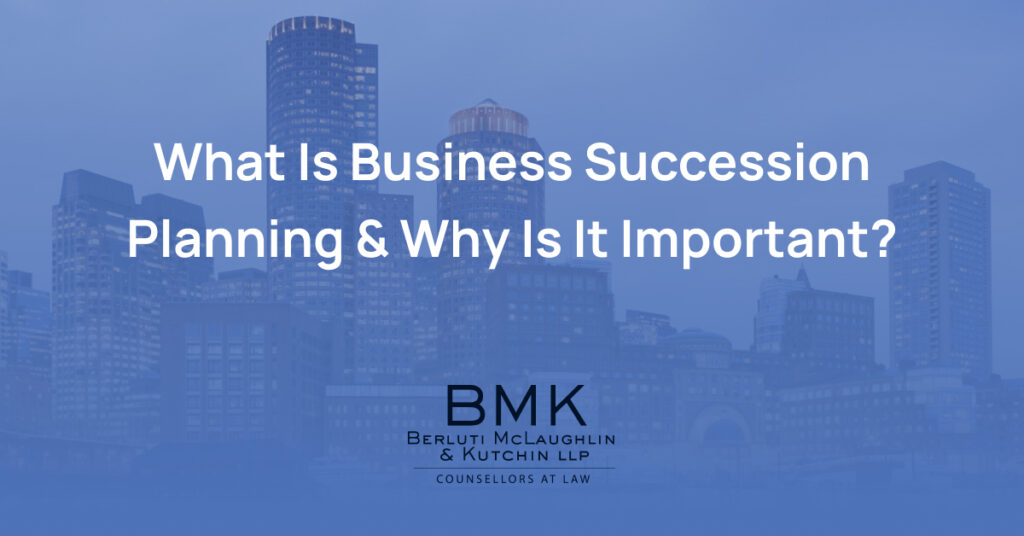
Every lasting business needs a succession plan—a method for new individuals to take over leadership positions. What is business succession planning in concrete terms? In short, business succession planning involves several phases. You assess what your business needs, what traits are most important for your company’s essential roles, how to identify individuals with those traits, and the most effective way to complete leadership transitions.
BMK Legal’s team has experience in a wide range of business and corporate issues. We can help you make a business succession plan to protect your legacy and empower future leaders to expand on what you have built.
Key Takeaways
- Business succession planning prepares organizations to replace key leaders and ensures operational continuity after departures.
- The process involves several phases, including evaluating operations, defining success traits, identifying talent, and developing transition steps.
- Clear, written standards help reduce bias and ensure successors are chosen based on qualifications, not assumptions.
- Training and mentorship opportunities are key to preparing employees for leadership roles and preserving institutional knowledge.
- Succession plans help businesses prepare for unexpected events, build employee loyalty, and strengthen long-term stability.
- Best practices include: prioritizing diversity, using objective metrics, maintaining flexibility, and addressing real-world operations—not just high-level goals.
What Is Business Succession Planning?
Succession planning is a strategic process to prepare new leaders to take over when current owners leave or retire. It identifies key roles, develops internal talent, and creates a transition plan to maintain business continuity. A full plan includes timelines, successors, valuation, and funding strategies.
When you start a business, you typically focus on what you must do now to succeed in the short term. As your plans come to fruition, you begin to explore what your business will look like in the long term. Succession plans typically involve several phases and should be refined along the way.
Business succession planning is the process of identifying and preparing internal leaders or external candidates to replace key roles in an organization, including the owner or CEO. It ensures operational continuity by establishing a structured plan to fill critical leadership and hard-to-replace positions. Use succession planning to transfer leadership roles and ensure business continuity after key personnel depart.
Evaluating Business Operations, Roles, and Challenges
To begin planning, assess how your organization runs, including:
- Who handles what responsibilities,
- How employees communicate when issues arise,
- What issues have you dealt with, and
- How you have previously resolved issues.
Compare your vision of ideal business operations to this practical and frank evaluation.
Next, identify which positions in your organization are crucial to its success. Consider the big picture and day-to-day operations.
Analyzing Successful Traits and Skills
Consider the crucial roles you identified and what traits, skills, and knowledge enable an individual to succeed, such as:
- What tasks does the role involve;
- What skills does a person need to succeed at those tasks;
- What knowledge, including organizational knowledge, do the tasks require;
- The relationship between various roles;
- The value of different perspectives; and
- How you might train these skills.
Create clear, written standards that can help minimize bias and embrace ingenuity.
Considering Potential Talent
Next, evaluate current and potential employees for leadership potential. Disclose what success looks like to set clear expectations and avoid overlooking potential based on misunderstandings.
Work with employees expressing an interest in leadership roles or show an aptitude for them. Provide training opportunities, possibilities for interpersonal relationship development, mentorship, or other programs that make sense for your business.
Establishing a Transition Process
Write out specific transition steps and disseminate the details to your employees. Address issues like:
- How long do you expect it to fully train someone for a role;
- What should the new supervisor should know;
- How will you ensure the transfer of knowledge during the transition, and
- Standards for when training is complete.
Consult trusted individuals within and outside the organization to refine this process.
Evaluating the Transition Process
When the time comes, push those who depart to follow your specific transition processes. Monitor what works, what does not, and what you can tweak to improve the process.
What Is the Importance of Succession Planning in a Business?
Many small business owners feel like they already have enough on their plates to ensure their business survives into the future. So, what is the importance of succession planning in a company?
Prepare for the Unexpected
Succession plans cover you should the unexpected happen. Establishing a plan before something goes wrong can mean the difference between your business thriving—or not surviving.
Establish Expectations and Set Goals
With clearly defined standards for success, your employees know what to do and how to do it. A succession plan also communicates to employees that you are interested in investing in their futures. Your employees, in turn, become more likely to invest their time and creativity into the business.
Succession Planning Best Practices
Begin succession planning by identifying key positions at risk of departure. To follow succession planning best practices, consider the following throughout the development, implementation, and evaluation processes:
- Diversity—work to establish objective standards and take the time to understand how implicit and explicit biases can limit your business’s potential;
- Training—tailor training to the unique position as it operates in your organization;
- Standardize—evaluate using carefully defined standards, not vague notions;
- Be practical—address practical day-to-day issues, not just the big picture; and
- Be flexible—reevaluate regularly and be willing to adapt your plans.
Take care not to get caught up in any one aspect of your succession plan. It should work as a cohesive whole.
Succession Planning Examples
Below, we explore two succession planning examples. The first details a less effective process, and the second examines a more successful one.
Succession Plan Example One
LLC One offers online storage for businesses that handle private information. Its two founders created a succession plan.
First, the founders:
- Made a list of their supervisors,
- Created job descriptions for those roles, and
- Compared and contrasted teams’ relative contributions.
Next, the founders evaluated each supervisor based on:
- Commitment,
- Interpersonal skills,
- Work history, and
- Technical skills.
They did not define those factors but combined them with their intuition as they:
- Observed each employee at work,
- Went through each employee one by one,
- Scored them on a scale of one to five, and
- Assigned those employees they considered to have leadership potential to a role.
The founders then directed the supervisors to train select employees to step into their roles before turning to other matters.
Succession Plan Example Two
The second succession plan example involves “Partnership Two,” which provides tax and accounting services. Partnership Two completed the following steps to create their succession plan.
First, the partners identified supervisors and other critical positions and created general job descriptions. Then, they reached out to their staff and asked for insights about:
- Corrections or additions to job descriptions,
- Which tasks do employees and supervisors consider essential, and
- Measuring performance metrics.
Next, the partners worked with their staff to develop a list of traits that suggested success, including:
- Specific accounting techniques supervisors should know;
- Qualifications supervisors should have, including education and experience; and
- Other knowledge a supervisor should have before taking over the role.
Then, the partners drafted a basic system outlining when and how an employee obtains more responsibilities in the company. They provided the description to all staff and requested feedback.
Next, they developed training programs that identified specific metrics to determine whether someone had the right skills and knowledge to climb the ladder. As they workshopped these programs and training strategies, the partners:
- Created documents detailing each process,
- Regularly asked for feedback, and
- Drafted tailored templates.
With each transition, the partners reevaluated what worked and what did not, continuing to tailor and perfect the process.
Getting Started with Small Business Succession Planning
Small business succession planning may sound daunting, but it can bring peace of mind, help you attract talent, and allow you to pass along your knowledge. BMK Legal’s broad experience allows us to guide and empower our clients to create succession plans that work for them. Contact us today.



